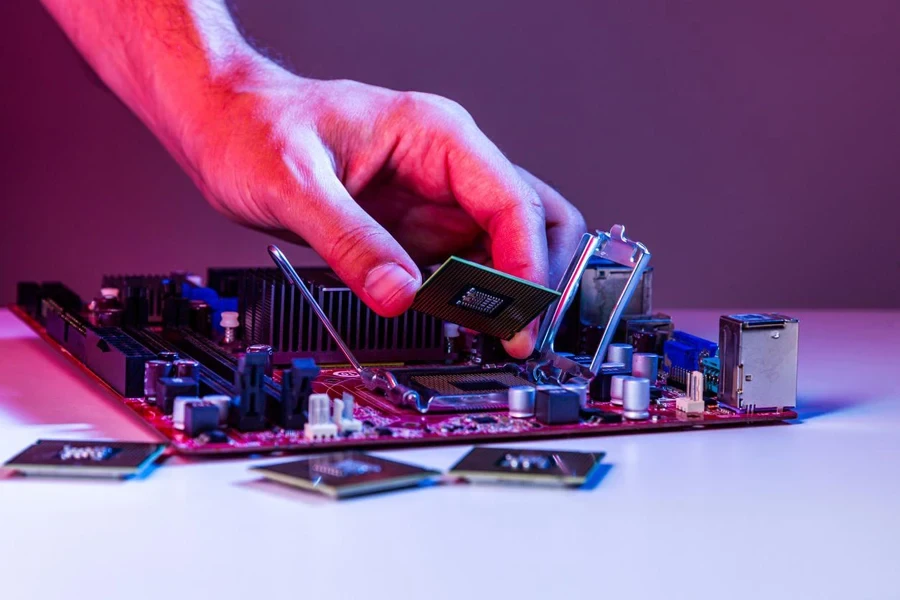Selecting the right audio processor can significantly impact audio performance and efficiency, providing nuanced control over sound quality across diverse applications. These devices are pivotal for enhancing audio clarity, managing sound levels, and fine-tuning tonal balance, making them essential tools in fields ranging from music production to broadcasting.
With 2024 bringing notable advancements in processing power, artificial intelligence integration, and compact designs, audio processors now offer more sophisticated functionality in smaller packages. Understanding these capabilities is vital for professionals to achieve high-quality, reliable audio output tailored to specific operational needs.
Table of Contents
1. Types of audio processors and their uses
2. Audio processor market overview in 2024
3. Essential factors for selecting the right audio processor
4. Leading audio processor models and features for 2025
5. Conclusion
Types of audio processors and their uses

Digital signal processors (DSPs)
Digital signal processors (DSPs) are key components in professional audio production, broadcasting, and live sound environments. They convert analog audio signals to digital form, allowing for detailed control over sound, such as balancing frequencies and managing dynamic range. DSPs are widely used for real-time effects, including reverb and delay, providing a clean, high-quality audio output. Many modern DSPs include preset adjustments and AI enhancements, allowing them to optimize sound based on real-time conditions automatically. This functionality has made DSPs essential in applications where clear, customized audio is paramount.
Analog processors
Analog processors bring a distinct, organic sound that is especially valued in settings where tonal warmth and natural harmonics are preferred. Operating without digital conversion, analog processors directly manipulate the audio signal using electrical circuits, often yielding a smoother, more genuine audio quality. They are commonly found in music production, film soundtracks, and live performances where a classic, rich sound is desired. Types of analog processors include compressors, equalizers, and limiters, each adding character to the audio, making them indispensable in environments prioritizing tonal depth and warmth over programmability.
Integrated audio interfaces
Integrated audio interfaces combine the functions of signal processing and connectivity, making them highly suitable for studios and complex audio setups. These devices act as bridges between digital audio workstations (DAWs), microphones, instruments, and other hardware, enabling seamless input and output. They often feature DSP technology, allowing users to add reverb, compression, and other effects directly within the interface, reducing reliance on external software and minimizing latency. With universal connectivity options like USB and Thunderbolt, integrated audio interfaces are compatible across platforms, providing versatility and simplicity in various professional settings. This integration makes them ideal for environments where high-quality sound and efficient workflow are crucial.
Audio processor market overview in 2024

Global demand trends
As of 2024, the global market for audio processors is experiencing substantial growth, valued at approximately USD 108.3 billion, with projections indicating it could reach USD 244.2 billion by 2031. This expansion, occurring at a compound annual growth rate (CAGR) of 14.2% from 2024 onward, is driven by rising demand across professional and consumer sectors. The need for high-quality audio has increased, particularly in applications such as home theaters, professional studios, and automotive sound systems, where clarity and immersive experiences are prioritized, according to insights from Audio Intensity.
High-resolution audio and spatial sound technologies are becoming the norm, particularly in streaming, gaming, and home entertainment, as consumers expect more immersive and refined sound experiences. North America and Asia-Pacific lead the market, driven by a strong demand for premium audio devices and a growing interest in advanced home entertainment systems. These trends create opportunities for companies to develop products that cater to advanced and emerging markets, highlighting the potential for innovation and differentiation within the audio processor segment.
Technological innovations and their impact
Technological advancements are transforming audio processors by making them smarter, more versatile, and more sustainable. AI-driven processors automatically adjust audio settings based on noise levels and user preferences, significantly enhancing sound quality in smart devices like speakers, headphones, and automotive audio systems. Spatial audio technology, including Dolby Atmos, adds depth and directionality, creating an immersive experience that is especially impactful in home theaters and gaming. Compact, multi-functional processors embedded directly into devices like smartphones and soundbars support wireless streaming through Bluetooth and Wi-Fi, enabling flexible, cable-free setups. With added emphasis on eco-friendly materials and energy-efficient designs, these innovations position audio processors as vital in delivering high-quality, adaptable, and sustainable sound across various applications.
Essential factors for selecting the right audio processor

Compatibility and application needs
When choosing an audio processor, it is critical to match its compatibility with the intended application, as different environments—such as music production, live events, or automotive sound systems—have unique requirements. Processors for live events must offer robust output options and minimal latency to avoid delays between audio input and the processed sound. In a studio setting, compatibility with various digital audio workstations (DAWs) and smooth integration with mixing consoles is essential. Ensuring compatibility reduces operational issues and helps achieve the desired audio quality from the outset.
Processing capabilities
Processing power is a core consideration for any audio processor, especially for complex applications requiring real-time effects. Important capabilities include handling equalization, compression, reverberation, and other modifications while keeping latency low. High-powered processors enable detailed sound adjustments and can manage multiple effects simultaneously, which is crucial in professional setups like music recording and event production. Models with flexible signal routing and additional features such as noise reduction and feedback control enhance audio quality, ensuring clarity and depth.
Build quality and durability

Durability is vital in professional audio environments, as processors are often used in demanding situations like concerts, broadcasting, and mobile setups. High-quality materials and strong construction contribute to a processor’s longevity, reducing the need for frequent maintenance. Reliable processors are designed to withstand intensive use and prevent overheating or component wear. For mobile or event-based applications, lightweight yet durable materials provide portability without sacrificing reliability.
Software support and updates
Regular software support and updates are crucial for maintaining compatibility with new technologies and enhancing processor functionality. Updates can add features and improve performance, which is essential in fast-evolving fields like audio engineering. Processors that offer app-based controls or remote adjustments through mobile devices also add convenience, especially useful in live sound environments. Continuous updates ensure compatibility with industry-standard software and operating systems, maximizing the processor’s relevance and usability over time.
Leading audio processor models and features for 2025
Top DSP models for high-fidelity sound
High-fidelity digital signal processors (DSPs) are distinguished by their superior sound clarity, depth, and versatility, meeting the demands of both professional and complex consumer audio applications. Top DSP models are known for their advanced features, such as precise equalization, time alignment, and channel mixing. These capabilities allow for a highly customizable audio experience for studios, live events, and broadcast settings. High-quality DSPs can handle multiple channels and provide low-latency performance, which is essential for achieving seamless sound reproduction in real-time environments.
Innovative hybrid audio interfaces

Hybrid audio interfaces that blend processing power with extensive connectivity are increasingly favored in production studios and live events. These interfaces typically offer a range of analog and digital inputs and outputs, often with integrated DSP functionality to facilitate real-time effects without additional software strain. Models in this category provide flexible compatibility across multiple devices, making them essential for setups requiring streamlined integration. High-resolution converters and fast connectivity options, such as USB-C or Thunderbolt, ensure reliable performance with minimal latency, helping users maintain sound quality even in complex, multi-device setups.
Compact processors with advanced AI capabilities
Compact audio processors with AI-driven capabilities are becoming essential in professional and home audio setups. These processors offer real-time adjustments based on environmental feedback or user preferences, enhancing sound quality dynamically. AI-based processors excel in applications where adaptive audio is crucial, such as live streaming or home smart audio systems, where sound quality must adjust seamlessly to shifting conditions. Their compact designs support easy integration in mobile or space-limited settings, with features like wireless streaming and cross-device compatibility further broadening their appeal. These AI-enhanced processors reflect the industry’s shift towards accessible, high-performance audio solutions that fit professional and consumer needs.
Conclusion
Choosing the right audio processor requires careful alignment with specific application needs, whether for live sound, studio production, or home entertainment. Key factors include ensuring compatibility with existing setups, evaluating processing capabilities for real-time performance, and prioritizing build quality to withstand professional demands.
Additionally, AI-driven sound adjustments and hybrid connectivity become valuable for future-proofing equipment as technology advances. By focusing on functionality that supports immediate and evolving audio requirements, decision-makers can confidently select processors that deliver exceptional sound quality, adaptability, and long-term reliability.




